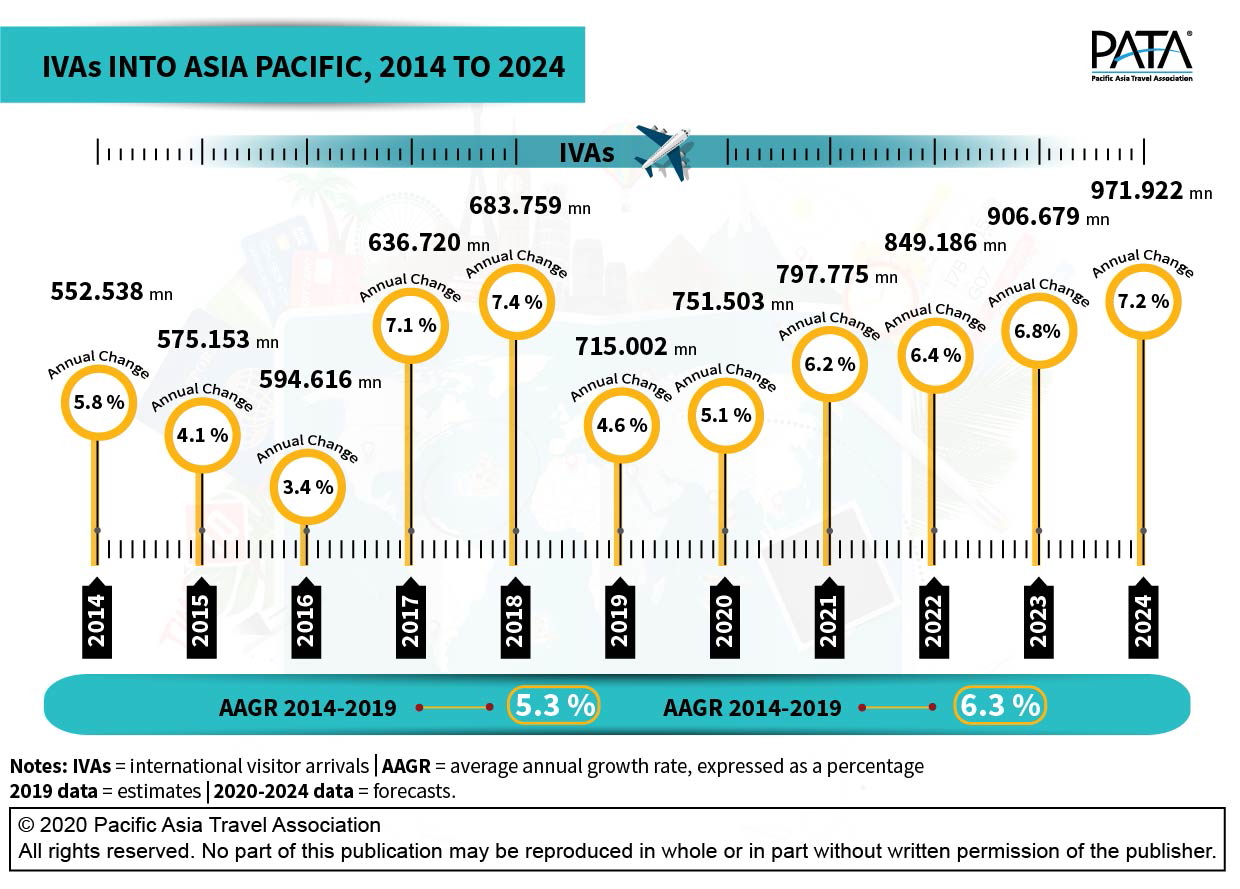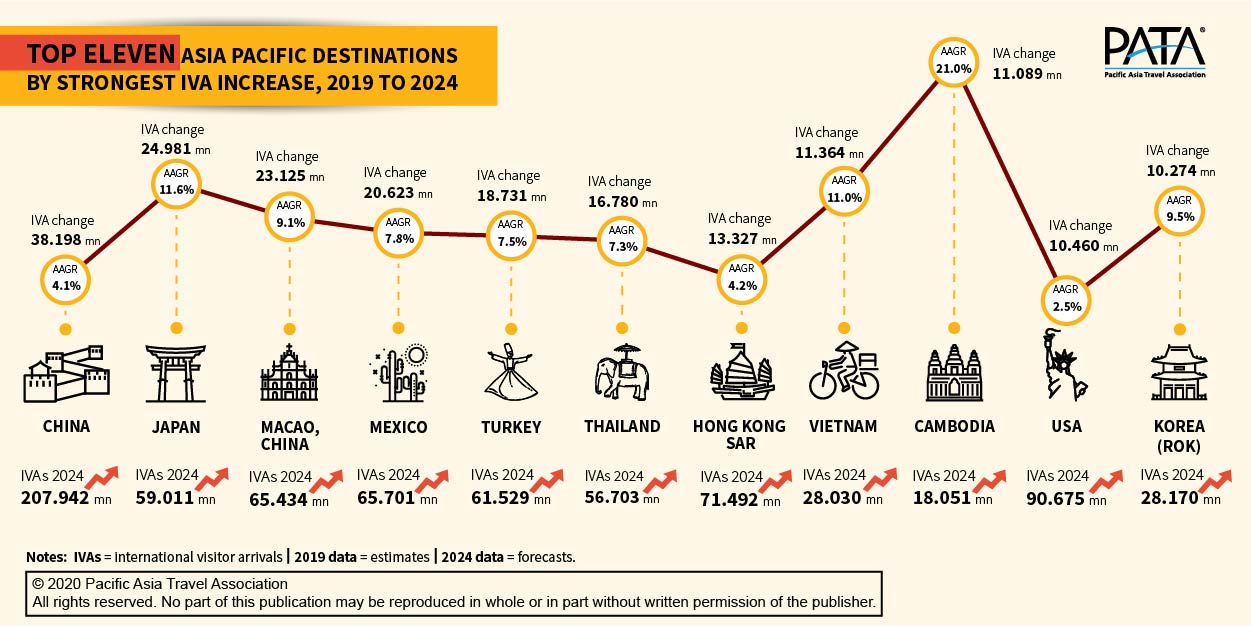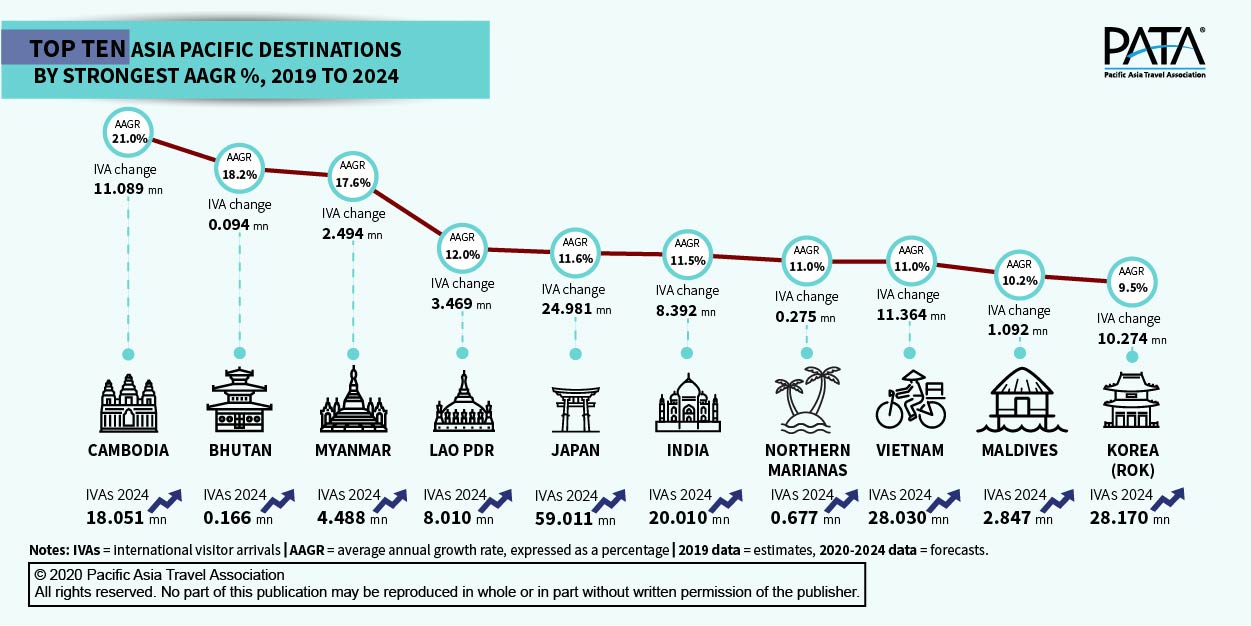|
PATA has forecast that the region it classifies as Asia Pacific,
which includes places like Turkey and the Americas, will welcome close to one billion
international visitor arrivals over the next five years.
That is one of the key predictions from the Executive Summary of
the Asia Pacific Visitor Forecasts 2020-2024, released on Monday
by PATA.
Covering the years 2019 to 2024 and 39 destinations, the
Executive Summary of the Asia Pacific Visitor Forecasts 2020-2024
shows that there could be over 971
million international visitor arrivals in the region by 2024.
However, destinations that you may consider to be
in Asia Pacific and those 39 destinations that PATA includes in
the forecast, may be very different. Here are the 39 destinations
included in the forecast: Australia, Bhutan, Cambodia, Canada,
Chile, China, Chinese Taipei, Cook Islands, Fiji, French
Polynesia, Guam, Hawaii, Hong Kong SAR, India, Indonesia, Japan,
Korea (ROK), Lao PDR, Macau SAR, Malaysia, Maldives, Mexico,
Mongolia, Myanmar, Nepal, New Caledonia, New Zealand, Northern
Marianas, Palau, Papua New Guinea, Philippines, Samoa, Singapore,
Sri Lanka, Thailand, Turkey, USA, Vanuatu and Vietnam.
From the West Asia region, the PATA report only
includes data from Turkey as it says that there is a lack of
sufficient data from the other destinations. West Asia, as defined
by the UN, consists of Bahrain, Cyprus, Iran, Iraq, Israel,
Jordan, Kuwait, Lebanon, Oman, Palestine, Qatar, Saudi Arabia,
Syria, Turkey, UAE, and Yemen.
Keeping all that in mind, the forecast increase in arrivals has been driven by the
average annual growth rate (AAGR) of 5.3% between 2014 and 2019,
and that momentum is expected to increase even further over the
next five years, to average 6.3% per annum between 2019 and 2024.

This will result in an acceleration of more than
256 million additional arrivals into the region between 2019 and 2024,
a significant increase over the additional volume of 162 million
added between 2014 and 2019.
The distribution of these arrivals in Asia Pacific is
expected to change only marginally from 2019, with the Asia and
Pacific regions expected to show some relative, as well as
absolute increases in arrival numbers.
Asia is forecast to remain the dominant
destination region and is likely to improve its relative share to
over 77% by 2024.The Americas will come in second, although its
share is expected to reduce slightly over the period between 2019
and 2024.
As a generator of arrivals into and across Asia
Pacific however, Asia is predicted to continue growing in relative
share, accounting for almost 68% of all arrivals into the region in
2024. This is likely to be at the expense of both the Americas and
Europe, both of which are predicted to wane, at least in terms of
their respective shares as source regions for Asia Pacific,
between 2014 and 2024.
Eleven Asia Pacific destinations are predicted to
each receive more than 10 million additional arrivals between 2019 and
2024, with China leading the way, expecting to add around 38.2
million more arrivals to its inbound count and raising the
aggregate volume to almost 208 million in 2024.

Japan is ranked next, followed by Macau, China and
then Mexico, with all of these destinations expected to receive
more than 20 million additional foreign arrivals each, over the
forecast period to 2024.
The top group of 11 destinations is likely to account for 77% of the
arrivals volume into
Asia Pacific in 2024 and more than three-quarters of the
additional arrivals over that same period.
In addition, it is predicted that nine out of ten
destinations will have AAGRs between 2019 and 2024 in excess of
10%, ranging from 10.2% for Maldives to 21% for Cambodia. The
volume bases for each of these destinations vary widely, however
these very strong average rates of growth are certainly worth
closely watching over the forecast period.

The top ten strongest source markets into Asia
Pacific between 2019 and 2024 are forecast to include China, the
Republic of Korea and Hong Kong SAR in the top three positions,
generating a collective volume of more than 369 million IVAs over
that period. These three source markets alone are also predicted
to generate an additional volume of more than 106 million arrivals
into Asia Pacific over the same period.
Much of that volume is of course, generated by
internal Greater China flows, especially from China into Macau,
China and Hong Kong SAR and to a lesser degree vice-versa.
PATA CEO Dr.
Mario Hardy, said, “For many destinations, there is now an
immediate and necessary shift from generating arrivals to properly
managing those visitors. It is no longer enough to think and talk
about this, the time to put into action such management practices
that ensure that visitors into and across the Asia Pacific region
receive a superlative and memorable experience is now. The tourism juggernaut is a reality, and this
means that, as a socio-economic sector, travel and tourism needs
to ensure that it has the necessary mindset and infrastructure –
both hard and soft – to enable growth of this magnitude to be
properly managed. It is incumbent upon us all to deliver both
memorable experiences and positive outcomes for visitors,
residents and the environment in equal measure.”
All the visitor arrivals data within the report
comes from each national tourism organization and/or national
statistic agency and their official websites. The forecasts are
produced in partnership with the Hong Kong Polytechnic University.
More on this, specifically
which countries PATA includes within Asia Pacific and where
countries in the Middle East are included, to come.
See also:
Did Strength of Thai Baht Affect Number of Visitor Arrivals from UK in
2019? FHD Video and Podcast Interview with Tourism Authority of
Thailand.
Published on TravelNewsAsia.com at:
https://www.asiatraveltips.com/news20/211-VisitorArrivals.shtml
See latest
Travel News,
Interviews,
Podcasts
and other
news regarding:
PATA,
Arrivals.
|
Headlines: |
|
|
